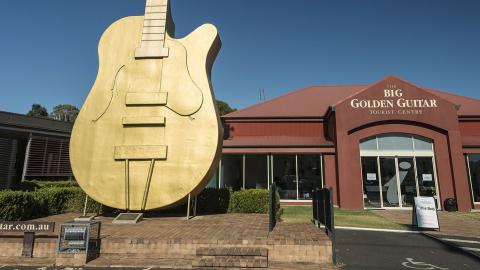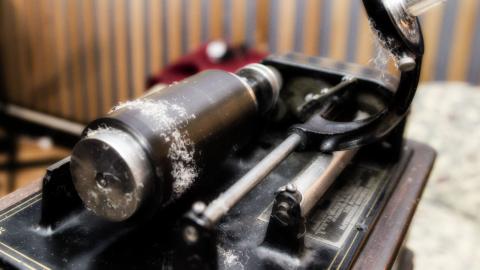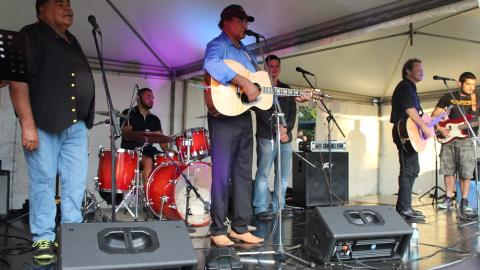

Tamworth Country Music Festival
Country stars give old technology a new spin
The NFSA’s Graham McDonald records Australian country music stars and emerging artists on lacquer disc at the Tamworth Country Music Festival. Artists taking part include Chad Morgan, Col Hardy and The Karen Lynne Band.
A selection of artists at the 2015 Tamworth Country Music Festival recording their music onto lacquer disc.
Graham explains how they achieved the best possible sound on the recordings.
We quite deliberately took the simplest approach, using just one microphone to capture the sound, whether from one person or a group. That required moving the microphone around to get a natural balance between the voice or voices and the instrumental accompaniment. We asked the performers to do what they would normally do performing acoustically and moved the microphone to best capture that.
When we recorded The Karen Lynne Band, it did involve some choreography around instrumental solos but using only one microphone is quite common in bluegrass music so it didn’t bother them.

What was especially useful was to have Chad Morgan come in and record. He is one of the very few, if not the only, surviving country performer who was recording in the 78 era, and who did their master recordings onto lacquer discs in the years before tape recorders replaced direct-to-disc recording.
He kindly showed me how the microphone would have been placed in the old EMI studios where he recorded in the 1950s and we used that placement for the rest of the recording sessions. The microphone was a bit higher and a bit closer to the mouth than we had been placing it and Chad reckoned it gave a bit more ‘presence’ to the recording. Who was I to argue with that!
How does recording on lacquer disc compare to recording on vinyl or wax cylinder?
Recording onto a lacquer disc is fundamentally the same as recording on a wax cylinder. In both cases we are trying to cut a wiggly groove in a relatively soft material. With the lacquer we have the advantage of electricity amplifying the sound so a bigger groove can be cut in the harder material, giving a better quality recording. It may not be what modern ears would call hi-fi but it is close to the quality that was pressed onto 78 rpm shellac records.

With a wax cylinder we are totally dependent on the energy of the sound waves from the instrument or voice actually moving a small disc to which the cutting stylus is attached.
Recording direct to lacquer disc became obsolete by the 1960s when tape recorders made recording quicker and cheaper, as well as allowing more flexibility in the process. Tape also made compiling LP albums more practical before the vinyl pressings were made.
The YouTube playlist below features full performances from Chad Morgan and The Karen Lynne Band, as well as Roger Knox, Col Hardy and Amber Lawrence.
Lawrence won the 2015 Golden Guitar award for Best Female Artist of the Year at Tamworth. Knox and Hardy also performed at the Freedom Ride concert.
Playlist of lacquer disc performances and recordings by Amber Lawrence, Chad Morgan, Roger Knox, The Karen Lynne Band and Col Hardy on the NFSA YouTube channel.
The National Film and Sound Archive of Australia acknowledges Australia’s Aboriginal and Torres Strait Islander peoples as the Traditional Custodians of the land on which we work and live and gives respect to their Elders both past and present.


